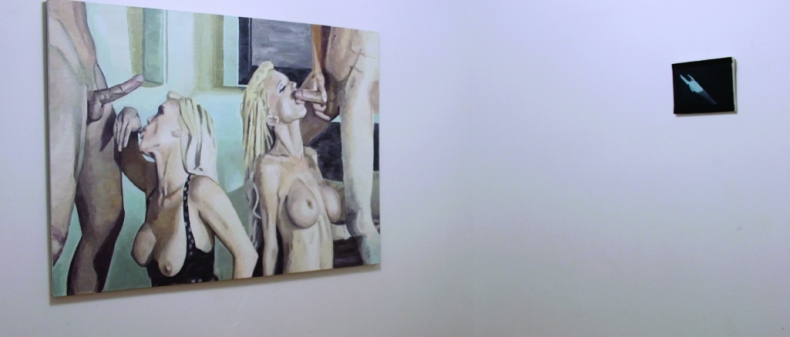
Undeniably, contemporary artists who work in paint know a thing or two about the history of that substance; undeniably, they are proponents (or at least closely dedicated students) of the “greatest” of all the canons of medium, identifying with the paintbrush, so heavy-handed in its esteem.
I sit in the elemental in-home studio of Brian Rideout, one such Toronto-based painter, surrounded by pieces that are a part of his upcoming solo show, AT THE RACES IN THE COUNTRYSIDE. The title comes from a reference to Degas’s painting of the same title; it was one of the first instances of a painter turning his easel on the viewer, his subjects becoming the wealthy and complacent viewers of a horserace rather than the exciting, racing horses themselves. The work represents a modernist turning-point, an early instance of conceptual awareness and rebellion. But looking at the piece now, uninitiated, without knowledge of the period or reference to other works, it looks traditional, a piece in a grandmother’s living room (albeit a very rich grandmother). That’s the power of art history, or that’s Rideout’s argument anyway.
In the landscape of Toronto painting, which currently subsists mostly on projection and abstraction, Rideout’s work is refreshing, bold, and referential to painting’s long place in history. With great representational ease, in the style of Gerard Richter or Luc Tuymans, his selection of 20 image appropriations have been re-phrased into a higher form as paintings; the reference material for these images comes from everything from thrown-away perfume advertisements to porno screen shots. It’s a cornucopia of ideology and charged material.
“Do you like them?” he asks me, lovingly hauling a selection of his paintings from the studio into the kitchen for optimal viewing. I nod. “I love looking at them all together,” he adds.
These new works are justly different from his past works, his sprawling acrylic and pencil crayon works of compounded, abstract, pulpy pop culture references. They were intentionally smudgy, unfinished. “I look at my old stuff and it makes me sick,” he says. “I just started oil painting in November and it opened up so many doors for me. I started making work that looked the way I wanted it to look.”
But what is looking? In a world with combustable images, is a new oil painter driven by aesthetic interests or a need to speak out with his work? “I don’t want to come off as judgemental. I don’t want people to think I’m saying anything bad in my paintings. Everything is good. Crazy bad stuff is good too. It’s all just about being human, being able to accept everything that happens within humanity. There’s no difference between who does good stuff and who does bad stuff. It’s so far beyond that.” The subject matter of Rideout’s new images is not all overtly similar, but the underlying theme seems to be something about the plight of humanity, our trouble with marketable perception, and a universally tangible interest in morality.
In a way, too, Rideout’s work, has always been a celebration of cultural monuments, of the loneliness of an image, of purity, of impunity, of heroes and villains. So with this show, is he waxing poetic on the internet age, on our heady consumption of images, on the New Aesthetic? There’s something more traditional about Rideout’s interpretation, something that suggests that his work is not entirely about the source of the images, but about the nature of the image in general, about the medium of painting, the agency and aura of the painting object. He seems to suggest that there is beauty in the narratives of our consuming images, even if things works differently with technology now.
“My work is not entirely representational. I wanted my paintings to look flat. I’m not a Modernist; I’m not trying to deceive anyone.” I ask him where he found the image references–did the porno painting come about in an organic situation? “Definitely. I was watching this porno and I was struck by how much like a painting the composition looked, and the colours.”
A series of 16 portraits are also included in the show of a famous German terrorist faction; he found the images in a book at a thrift shop, scanned them to his computer, and then lost the book. “I was really bummed for a long time, and so I started doing research. But then I realized I didn’t want to get too much information, because I didn’t want to lose that initial interest I had in the images. That’s how I want to present them… Ambiguously.”
And maybe that’s the best part of Brian’s work. Like any good artist, he’s interested in how he sees, or in how we all see. “I spend so much time looking. We all spend so much time looking. Painting for me is how I’ve learned everything about the world, through art history, and how I continue to learn about how I view the world. To me, I think art history is the best way to learn about social movements, to learn about changes in the world, to learn about everything that has happened in all of history, especially because it’s the only way history’s been documented for most of it… What I like about painting is my focus; that’s when I have time to think about what my paintings are about. I’m constantly mulling them over going, what the fuck am I doing?”
Brian Rideout’s show AT THE RACES IN THE COUNTRYSIDE opens at Butcher Gallery (4 Northern Place) on April 20, 2012 from 7-10pm.
—–
…Jessica Carroll writes about art. Follow her on Twitter at @jssckr.
For more, follow us on Twitter at @torontostandard, and subscribe to our newsletter.














